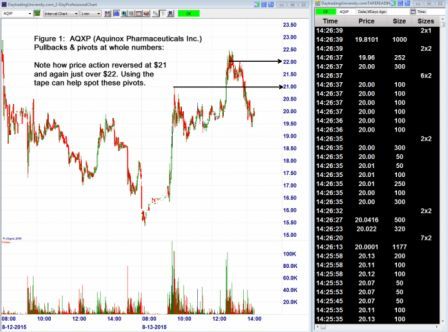Using time and sales to enter and exit momentum day trades is an effective tool that professional traders rely upon to help manage their trades. In our earlier 2012 tape reading article, we looked at top entry signals. In this article you’ll learn how to combine tape reading with whole-number resistance levels, to exit your trades. We’ll focus on long trade examples – Ken Calhoun.
Tape Reading Exits: When to Sell
As trades are made during live markets, the share size and time of transaction are shown in the time & sales window, known as the “tape” (included in charting software programs w/realtime data). After entering your position, it’s critical to know when to sell, either with a ten-to-forty cent stop loss for bad trades, or a forty-cent to $1+ win for winning day trades.
There’s several clues the astute day trader uses to help identify when to close an open winning position, to lock in a profit:
a) Momentum of the tape: is the transaction speed slowing down? If price-action stalls, or the number of trades per minute goes down, then buyers may be slowing, leading to an upcoming drop in share price.
b) Failure to take out new highs: If price seems “stuck” in a given ten-cent trading range for 30 to 60 seconds or longer, it may mean not enough new buyers are trading long, leading to a reversal.
c) Slowing near key resistance levels: As price action in time & sales gets closer to a prior high (either current-day or prior day resistance), the tape may slow down, indicating buyers are not coming into the stock, which can also lead to a pullback or downward pivot.
Reading the Tape Into Whole Number Resistance
One good example of “slowing near key resistance levels” can be found in Figure 1, Aquinox Pharmaceuticals (AQXP). In this chart, we see a common tape reading phenomenon, in which whole numbers (in this case, both $21/share and $22/share) provided resistance levels.

If you are in a long trade, it’s often wise to sell right under whole numbers, using tape reading price action as your guide. Similarly, it’s a bad idea to enter any day trade right under a whole number, eg within ten to twenty cents (for example $21.8 or $21.9) because price often stalls and drops at the whole numbers.
Retail and professional traders alike use whole numbers to simplify trading decisions, so using tape reading to capitalize on this common occurrence makes sense, for early profit-taking. Look for combinations of a) slowing momentum, b) failure to take out new highs, and c) slowing near key resistance levels, such as whole numbers, as part of a professional tape reading approach.
Recommended resource: For more on using this and other trading strategies, see the author’s complimentary Saturday “Trading Week Ahead’ webinar events at TradeMastery.com/free
Ken Calhoun is a trading professional who has traded millions of dollars of equities since the 1990s, and is the producer of multiple award-winning trading courses and video-based training systems for active traders. Ken Calhoun is a UCLA alumnus and founder of Daytrading University, TradeMastery.com and StockTradingSuccess.com (with Steve Nison), popular online educational sites that reach tens of thousands of active traders worldwide.